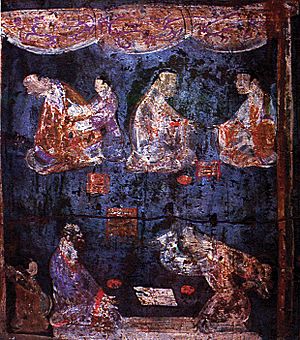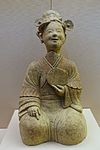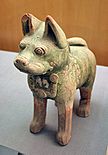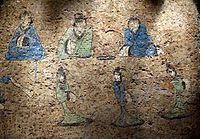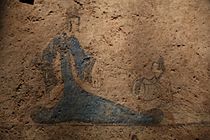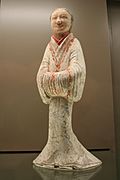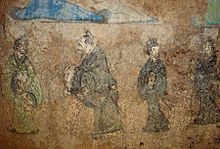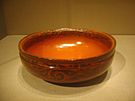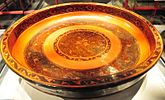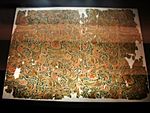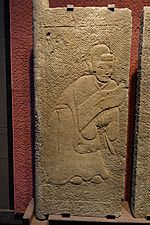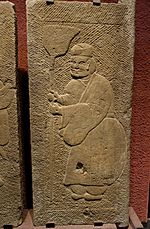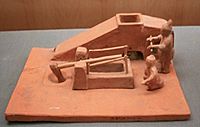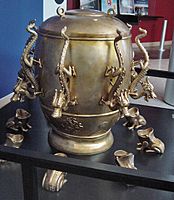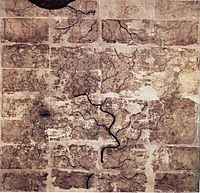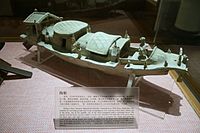Han dynasty facts for kids
Quick facts for kids
Han
|
|||||||||||||||
|---|---|---|---|---|---|---|---|---|---|---|---|---|---|---|---|
|
|||||||||||||||
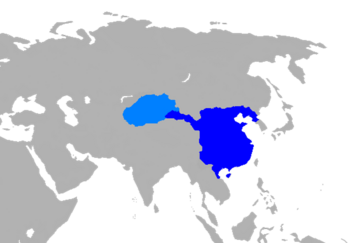
A map of the Western Han dynasty in 2 AD
|
|||||||||||||||
| Capital | Chang'an (206 BC – 9 AD, 190–195 AD) Luoyang (23–190 AD, 196 AD) Xuchang (196–220 AD) |
||||||||||||||
| Common languages | Old Chinese | ||||||||||||||
| Religion | Daoism Chinese folk religion |
||||||||||||||
| Government | Monarchy | ||||||||||||||
| Emperor | |||||||||||||||
|
• 202–195 BC (first)
|
Emperor Gaozu | ||||||||||||||
|
• 141–87 BC
|
Emperor Wu | ||||||||||||||
|
• 74–48 BC
|
Emperor Xuan | ||||||||||||||
| Chancellor | |||||||||||||||
|
• 206–193 BC
|
Xiao He | ||||||||||||||
|
• 193–190 BC
|
Cao Can | ||||||||||||||
|
• 189–192 AD
|
Dong Zhuo | ||||||||||||||
|
• 208–220 AD
|
Cao Cao | ||||||||||||||
|
• 220 AD
|
Cao Pi | ||||||||||||||
| Historical era | Imperial | ||||||||||||||
|
• Xiang Yu appointed Liu Bang as King of Han
|
206 BC | ||||||||||||||
|
• Battle of Gaixia; Liu Bang proclaimed emperor
|
202 BC | ||||||||||||||
|
• Xin dynasty
|
9–23 AD | ||||||||||||||
|
• Abdication to Cao Wei
|
220 AD | ||||||||||||||
| Area | |||||||||||||||
| 50 BC est. (Western Han peak) | 6,000,000 km2 (2,300,000 sq mi) | ||||||||||||||
| 100 AD est. (Eastern Han peak) | 6,500,000 km2 (2,500,000 sq mi) | ||||||||||||||
| Population | |||||||||||||||
|
• 2 AD
|
57,671,400 | ||||||||||||||
| Currency | Ban Liang coins and Wu Zhu coins | ||||||||||||||
|
|||||||||||||||
| Today part of | China Vietnam North Korea |
||||||||||||||
| Han dynasty | |||||||||||||||||||||||||||||||||||||||||||
|---|---|---|---|---|---|---|---|---|---|---|---|---|---|---|---|---|---|---|---|---|---|---|---|---|---|---|---|---|---|---|---|---|---|---|---|---|---|---|---|---|---|---|---|
| Han dynasty | |||||||||||||||||||||||||||||||||||||||||||

"Han" in ancient seal script (top left), Han-era clerical script (top right), modern Traditional (bottom left), and Simplified (bottom right) Chinese characters
|
|||||||||||||||||||||||||||||||||||||||||||
| Traditional Chinese | 漢 | ||||||||||||||||||||||||||||||||||||||||||
| Simplified Chinese | 汉 | ||||||||||||||||||||||||||||||||||||||||||
| Hanyu Pinyin | Hàn | ||||||||||||||||||||||||||||||||||||||||||
|
|||||||||||||||||||||||||||||||||||||||||||
| History of China | |||||||
|---|---|---|---|---|---|---|---|
| ANCIENT | |||||||
| Neolithic c. 8500 – c. 2070 BC | |||||||
| Xia dynasty c. 2070 – c. 1600 BC | |||||||
| Shang dynasty c. 1600 – c. 1046 BC | |||||||
| Zhou dynasty c. 1046 – 256 BC | |||||||
| Western Zhou | |||||||
| Eastern Zhou | |||||||
| Spring and Autumn | |||||||
| Warring States | |||||||
| IMPERIAL | |||||||
| Qin dynasty 221–206 BC | |||||||
| Han dynasty 206 BC – 220 AD | |||||||
| Western Han | |||||||
| Xin dynasty | |||||||
| Eastern Han | |||||||
| Three Kingdoms 220–280 | |||||||
| Wei, Shu and Wu | |||||||
| Jin dynasty 265–420 | |||||||
| Western Jin | |||||||
| Eastern Jin | Sixteen Kingdoms | ||||||
| Southern and Northern Dynasties 420–589 |
|||||||
| Sui dynasty 581–618 | |||||||
| Tang dynasty 618–907 | |||||||
| (Wu Zhou interregnum 690–705) | |||||||
| Five Dynasties and Ten Kingdoms 907–960 |
Liao dynasty 907–1125 |
||||||
| Song dynasty 960–1279 |
|||||||
| Northern Song | W. Xia | ||||||
| Southern Song | Jin | ||||||
| Yuan dynasty 1271–1368 | |||||||
| Ming dynasty 1368–1644 | |||||||
| Qing dynasty 1644–1911 | |||||||
| MODERN | |||||||
| Republic of China 1912–1949 | |||||||
| People's Republic of China 1949–present |
Republic of China on Taiwan 1949–present |
||||||
|
Related articles
|
|||||||
The Han dynasty ( Chinese: 漢朝; pinyin: Hàncháo) was an imperial dynasty of China (202 BC – 9 AD, 25–220 AD), established by Liu Bang (Emperor Gao) and ruled by the House of Liu. Spanning over four centuries, the Han dynasty is considered a golden age in Chinese history, and it has influenced the identity of the Chinese civilization ever since.
Modern China's majority ethnic group refers to themselves as the "Han people", the Sinitic language is known as "Han language", and the written Chinese is referred to as "Han characters".
Contents
Etymology
According to the Records of the Grand Historian, after the collapse of the Qin dynasty the hegemon Xiang Yu appointed Liu Bang as prince of the small fief of Hanzhong, named after its location on the Han River (in modern southwest Shaanxi). Following Liu Bang's victory in the Chu–Han Contention, the resulting Han dynasty was named after the Hanzhong fief.
History
The dynasty was preceded by the short-lived Qin dynasty (221–207 BC) and a warring interregnum known as the Chu–Han contention (206–202 BC), and it was succeeded by the Three Kingdoms period (220–280 AD).
The dynasty was briefly interrupted by the Xin dynasty (9–23 AD) established by usurping regent Wang Mang, and is thus separated into two periods—the Western Han (202 BC – 9 AD) and the Eastern Han (25–220 AD).
Government
The emperor was at the centre of Han society. He presided over the Han government but shared power with both the nobility and appointed ministers who came largely from the scholarly gentry class.
The Han Empire was divided into areas directly controlled by the central government called commanderies, as well as a number of semi-autonomous kingdoms. These kingdoms gradually lost their independence, particularly following the Rebellion of the Seven States. From the reign of Emperor Wu (r. 141 – 87 BC) onward, the Chinese court officially sponsored Confucianism in education and court politics. This policy endured until the fall of the Qing dynasty in 1912 AD.
Economy
The Han dynasty saw an age of economic prosperity and witnessed a significant growth of the money economy first established during the Zhou dynasty (c. 1050–256 BC). The coinage issued by the central government mint in 119 BC remained the standard coinage of China until the Tang dynasty (618–907 AD). The period saw a number of limited institutional innovations. To finance its military campaigns and the settlement of newly conquered frontier territories, the Han government nationalized the private salt and iron industries in 117 BC, though these government monopolies were later repealed during the Eastern Han dynasty.
Conflicts
The Han dynasty is known for the many conflicts it had with the Xiongnu, a nomadic steppe confederation to the dynasty's north. The Xiongnu defeated the Han in 200 BC and forced the Han to become a vassal partner for several decades, while continuing their military raids on the dynasty's borders.
This changed in 133 BC, during the reign of Emperor Wu, when Han forces began a series of intensive military campaigns and operations against the Xiongnu. The Han defeated the Xiongnu in these campaigns, and the Xiongnu were forced to accept vassal status. Additionally, the campaigns helped establish the vast trade network known as the Silk Road, which reached as far as the Mediterranean world. The Silk Road helped make a political, economic, military, and culture center, but it was very expensive to manage and further expansion was cut off.
The territories north of Han's borders were later overrun by the nomadic Xianbei confederation. Emperor Wu also launched successful military expeditions in the south, annexing Nanyue in 111 BC and Dian in 109 BC. He further expanded Han territory into the northern Korean Peninsula, where Han forces conquered Gojoseon and established the Xuantu and Lelang Commanderies in 108 BC.
End of the Han dynasty
After 92 AD, violent power struggles between the various consort clans of the empresses and empresses dowager caused the Han's ultimate downfall. Following the death of Emperor Ling (r. 168 – 189 AD), members of the aristocracy and military governors managed to become warlords and divide the empire.
When Cao Pi, king of Wei, usurped the throne from Emperor Xian, the Han dynasty ceased to exist.
Culture and society

Social class
In the hierarchical social order, the emperor was at the very top of Han society and government. However, the emperor was often a minor, ruled over by a regent such as the empress dowager or one of her male relatives. Ranked immediately below the emperor were the kings who were of the same Liu family clan. The rest of society, including nobles lower than kings and all commoners excluding slaves, belonged to one of twenty ranks (ershi gongcheng 二十公乘).
Each successive rank gave its holder greater pensions and legal privileges. The highest rank, of full marquess, came with a state pension and a territorial fiefdom.
By the Eastern Han period, local elites of unattached scholars, teachers, students, and government officials began to identify themselves as members of a larger, nationwide gentry class with shared values and a commitment to mainstream scholarship.
The farmer, or specifically the small landowner-cultivator, was ranked just below scholars and officials in the social hierarchy. Other agricultural cultivators were of a lower status, such as tenants, wage laborers, and slaves. Artisans, technicians, tradespeople, and craftsmen had a legal and socioeconomic status between that of owner-cultivator farmers and common merchants.
State-registered merchants, who were forced by law to wear white-colored clothes and pay high commercial taxes, were considered by the gentry as social parasites with a contemptible status. These were often petty shopkeepers of urban marketplaces; merchants such as industrialists and itinerant traders working between a network of cities could avoid registering as merchants and were often wealthier and more powerful than the vast majority of government officials.
Medical physicians, pig breeders, and butchers had a fairly high social status, while occultist diviners, runners, and messengers had low status.
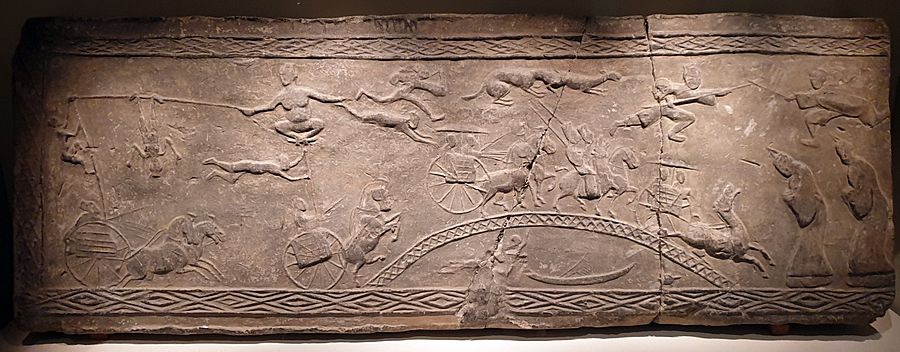
Marriage, gender, and kinship
Right: a dog figurine found in a Han tomb wearing a decorative dog collar, indicating their domestication as pets. Dog figurines are a common archaeological find in Han tombs, while it is also known from written sources that the emperor's imperial parks had kennels for keeping hunting dogs.
The Han-era family was patrilineal and typically had four to five nuclear family members living in one household.
Marriages were highly ritualized, particularly for the wealthy, and included many important steps. The giving of betrothal gifts, known as bridewealth and dowry, were especially important. A lack of either was considered dishonorable. Arranged marriages were normal, with the father's input on his offspring's spouse being considered more important than the mother's.
Under certain conditions dictated by custom, not law, both men and women were able to divorce their spouses and remarry. However, a woman who had been widowed continued to belong to her husband's family after his death. In order to remarry, the widow would have to be returned to her family in exchange for a ransom fee. Her children would not be allowed to go with her.
Women were expected to obey the will of their father, then their husband, and then their adult son in old age. The most common occupation for women was weaving clothes for the family, for sale at market, or for large textile enterprises that employed hundreds of women. Other women helped on their brothers' farms or became singers, dancers, sorceresses, respected medical physicians, and successful merchants who could afford their own silk clothes.
Education, literature, and philosophy
The Imperial University grew in importance as the student body grew to over 30,000 by the 2nd century CE. A Confucian-based education was also made available at commandery-level schools and private schools opened in small towns, where teachers earned respectable incomes from tuition payments. Schools were established in far southern regions where standard Chinese texts were used to assimilate the local populace.
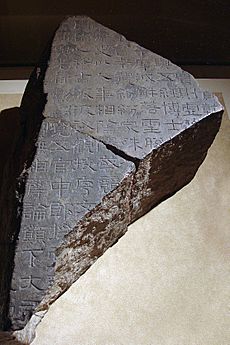
Some important texts were created and studied by scholars. Philosophical works written by Yang Xiong (53 BCE – 18 CE), Huan Tan (43 BCE – 28 CE), Wang Chong (27–100 CE), and Wang Fu (78–163 CE) questioned whether human nature was innately good or evil and posed challenges to Dong's universal order. The Records of the Grand Historian by Sima Tan (d. 110 BCE) and his son Sima Qian (145–86 BCE) established the standard model for all of imperial China's Standard Histories, such as the Book of Han written by Ban Biao (3–54 CE), his son Ban Gu (32–92 CE), and his daughter Ban Zhao (45–116 CE). There were dictionaries such as the Shuowen Jiezi by Xu Shen (c. 58 – c. 147 CE) and the Fangyan by Yang Xiong.
Biographies on important figures were written by various gentrymen. Han dynasty poetry was dominated by the fu genre, which achieved its greatest prominence during the reign of Emperor Wu.
Food
The most common staple crops consumed during Han were wheat, barley, foxtail millet, proso millet, rice, and beans. Commonly eaten fruits and vegetables included chestnuts, pears, plums, peaches, melons, apricots, strawberries, red bayberries, jujubes, calabash, bamboo shoots, mustard plant, and taro. Domesticated animals that were also eaten included chickens, Mandarin ducks, geese, cows, sheep, pigs, camels, and dogs (various types were bred specifically for food, while most were used as pets). Turtles and fish were taken from streams and lakes. Commonly hunted game, such as owl, pheasant, magpie, sika deer, and Chinese bamboo partridge were consumed. Seasonings included sugar, honey, salt, and soy sauce. Beer and wine were regularly consumed.
Clothing
The types of clothing worn and the materials used during the Han period depended upon social class. Wealthy folk could afford silk robes, skirts, socks, and mittens, coats made of badger or fox fur, duck plumes, and slippers with inlaid leather, pearls, and silk lining. Peasants commonly wore clothes made of hemp, wool, and ferret skins.
Religion, cosmology, and metaphysics
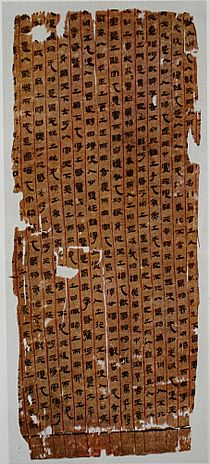
Families throughout Han China sacrificed animals and food to deities, spirits, and ancestors at temples and shrines. It was thought that each person had a two-part soul: the spirit-soul (hun 魂) which journeyed to the afterlife paradise of immortals (xian), and the body-soul (po 魄) which remained in its grave or tomb on earth and was only reunited with the spirit-soul through a ritual ceremony.
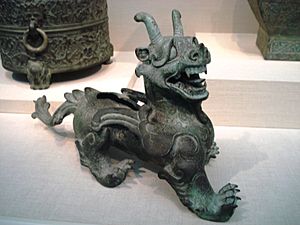
In addition to his many other roles, the emperor acted as the highest priest. If the emperor did not behave according to proper ritual, ethics, and morals, he could disrupt the fine balance of these cosmological cycles and cause calamities such as earthquakes, floods, droughts, epidemics, and swarms of locusts.
It was believed that immortality could be achieved if one reached the lands of the Queen Mother of the West or Mount Penglai.
Buddhism first entered Imperial China through the Silk Road during the Eastern Han, and was first mentioned in 65 CE. China's first known Buddhist temple, the White Horse Temple, was constructed outside the wall of the capital, Luoyang, during Emperor Ming's reign. Important Buddhist canons were translated into Chinese during the 2nd century CE, including the Sutra of Forty-two Chapters, Perfection of Wisdom, Shurangama Sutra, and Pratyutpanna Sutra.
Science and technology
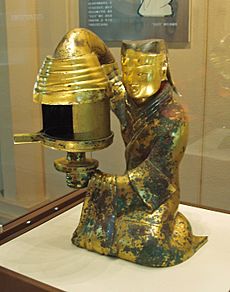
The Han dynasty was a unique period in the development of premodern Chinese science and technology, comparable to the level of scientific and technological growth during the Song dynasty (960–1279). Science and technology during the Han period saw significant advances, including the process of papermaking, the nautical steering ship rudder, the use of negative numbers in mathematics, the raised-relief map, the hydraulic-powered armillary sphere for astronomy, and a seismometer employing an inverted pendulum that could be used to discern the cardinal direction of distant earthquakes.
Writing materials
In the 1st millennium BC, typical ancient Chinese writing materials were bronzewares, animal bones, and bamboo slips or wooden boards. By the beginning of the Han dynasty, the chief writing materials were clay tablets, silk cloth, hemp paper, and rolled scrolls made from bamboo strips sewn together with hempen string; these were passed through drilled holes and secured with clay stamps.
The oldest known Chinese piece of hempen paper dates to the 2nd century BC. The standard papermaking process was invented by Cai Lun (AD 50–121) in 105. The oldest known surviving piece of paper with writing on it was found in the ruins of a Han watchtower that had been abandoned in AD 110, in Inner Mongolia.
Mechanical and hydraulic engineering
In 15 BC the philosopher and poet Yang Xiong described the invention of the belt drive for a quilling machine, which was of great importance to early textile manufacturing.Around AD 180, mechanical engineer and craftsman Ding Huan created a manually operated rotary fan used for air conditioning within palace buildings.
The waterwheel appeared in Chinese records during the Han. They were used to turn gears that lifted iron trip hammers, and were used in pounding, threshing, and polishing grain. The Nanyang Commandery Administrator, mechanical engineer, and metallurgist Du Shi (d. 38 AD) created a waterwheel-powered reciprocator that worked the bellows for the smelting of iron. Waterwheels were also used to power chain pumps that lifted water to raised irrigation ditches.
The armillary sphere, a three-dimensional representation of the movements in the celestial sphere, was invented in Han China by the 1st century BC. Using a water clock, waterwheel, and a series of gears, the Court Astronomer Zhang Heng (AD 78–139) was able to mechanically rotate his metal-ringed armillary sphere.
Zhang also invented a device he termed an "earthquake weathervane" (houfeng didong yi 候風地動儀), the ancestor of all seismographs. This device was able to detect the exact cardinal or ordinal direction of earthquakes from hundreds of kilometers away. It employed an inverted pendulum that, when disturbed by ground tremors, would trigger a set of gears that dropped a metal ball from one of eight dragon mouths (representing all eight directions) into a metal toad's mouth.
-
A modern replica of Zhang Heng's seismometer
Mathematics
One of the Han's greatest mathematical advancements was the world's first use of negative numbers. Negative numbers were also used by the Greek mathematician Diophantus around AD 275, and in the 7th-century Bakhshali manuscript of Gandhara, South Asia, but were not widely accepted in Europe until the 16th century.
The Han applied mathematics to various diverse disciplines. In musical tuning, Jing Fang (78–37 BC) realized that 53 perfect fifths was approximate to 31 octaves while creating a musical scale of 60 tones, calculating the difference at 177147⁄176776 (the same value of 53 equal temperament discovered by the German mathematician Nicholas Mercator [1620–1687], i.e. 353/284).
Astronomy
During the spring and autumn periods of the 5th century BC, the Chinese established the Sifen calendar (古四分历), which measured the tropical year at 365.25 days. This was replaced in 104 BC with the Taichu calendar (太初曆) that measured the tropical year at 365⁄385 (~ 365.25016) days and the lunar month at 29⁄43 days. However, Emperor Zhang later reinstated the Sifen calendar.
Han Chinese astronomers made star catalogues and detailed records of comets that appeared in the night sky, including recording the 12 BC appearance of the comet now known as Halley's Comet.
Han dynasty astronomers adopted a geocentric model of the universe, theorizing that it was shaped like a sphere surrounding the earth in the center. They assumed that the Sun, Moon, and planets were spherical and not disc-shaped. They also thought that the illumination of the Moon and planets was caused by sunlight, that lunar eclipses occurred when the Earth blocked sunlight falling onto the Moon, and that a solar eclipse occurred when the Moon blocked sunlight from reaching the Earth. Although others disagreed with his model, Wang Chong accurately described the water cycle of the evaporation of water into clouds.
Cartography, ships, and vehicles
The general Ma Yuan created the world's first known raised-relief map from rice in the 1st century. There is evidence that in the early 2nd century, cartographer Zhang Heng was the first to use scales and grids for maps.
Han dynasty Chinese sailed in a variety of ships different from those of previous eras, such as the tower ship. The junk design was developed and realized during the Han era. Junk ships featured a square-ended bow and stern, a flat-bottomed hull or carvel-shaped hull with no keel or sternpost, and solid transverse bulkheads in the place of structural ribs found in Western vessels. Moreover, Han ships were the first in the world to be steered using a rudder at the stern, in contrast to the simpler steering oar used for riverine transport, allowing them to sail on the high seas.
Although ox-carts and chariots were previously used in China, the wheelbarrow was first used in Han China in the 1st century BC. Han artwork of horse-drawn chariots shows that the Warring-States-Era heavy wooden yoke placed around a horse's chest was replaced by the softer breast strap. Later, during the Northern Wei (386–534), the fully developed horse collar was invented.
-
An early Western Han dynasty silk map found in tomb 3 of Mawangdui, depicting the Kingdom of Changsha and Kingdom of Nanyue in southern China (note: the south direction is oriented at the top).
Medicine
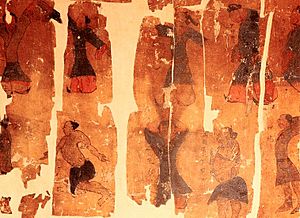
Han-era medical physicians believed that the human body was subject to the same forces of nature that governed the greater universe, namely the cosmological cycles of yin and yang and the five phases. Each organ of the body was associated with a particular phase. Illness was viewed as a sign that qi or "vital energy" channels leading to a certain organ had been disrupted. Thus, Han-era physicians prescribed medicine that was believed to counteract this imbalance.
For example, since the wood phase was believed to promote the fire phase, medicinal ingredients associated with the wood phase could be used to heal an organ associated with the fire phase. When surgery was performed by the Chinese physician Hua Tuo (d. AD 208), he used anesthesia to numb his patients' pain and prescribed a rubbing ointment that allegedly sped the process of healing surgical wounds.
See also
 In Spanish: Dinastía Han para niños
In Spanish: Dinastía Han para niños



